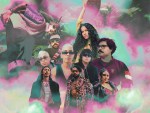The Mess is a new column from journalist Richard Villegas, who has been reporting on new, exciting sounds flourishing in the Latin American underground for nearly a decade. As the host of the Songmess Podcast, his travels have intersected with fresh sounds, scene legends, ancestral traditions, and the socio-political contexts that influence your favorite artists. The Mess is about new trends and problematic faves whilst asking hard questions and shaking the table.
We’re going there. We’re talking about it. Even if things get a little messy.
Thank goodness the Ghibli trend is dead. You know, the AI-generated mess that swept the internet earlier this month, inflicting the public with anime reimaginings of famous memes, followed by its eventual tía-fication into an environmentally ruinous selfie filter. Sorry, but a Piolín sticker on your wedding photos is nowhere near the water cost of using ChatGPT. Trite trends are daily occurrences on social media. And when artificial intelligence mimics the style of Studio Ghibli, I don’t expect users to consider how the trailblazing legacy of Japanese animator Hayao Miyazaki is being stolen and trivialized. However, I am alarmed by the ease with which fellow artists are hopping on the AI bandwagon, turning a blind eye to corporate theft of intellectual property and increasingly cutting technical skill out of the creative process. Economic precarity and declining solidarity for the labor of our peers forecasts a grim, selfish future for art. And since turning back the clock isn’t an option, it’s time to figure out where AI fits in the greater picture without blindly marching into neo-feudalism.
At the risk of sounding like a geezer, I’ll admit I’ve never used ChatGPT or its siblings. I transcribe, translate, and draft all my interviews and scene reports, even if the process is slower and more tedious. But bumpy contours are proof of human hands at work. I earned my credibility over a decade of niche journalism, and getting caught on a shortcut can flush it all away. In my mind, an artist’s journey isn’t so different. Music producers fussing for days over the right high hat for a beat, or painters whose strokes don’t quite match the image in their mind, will eventually hone their skills over the proverbial 10,000 hours. Practice and a gradually developed signature convey emotion and care that no AI prompt can fully replicate, even if cartoonishly greedy tech giants try to convince us otherwise.

Last year, Spotify’s CEO Daniel Ek received backlash for claiming, “the cost of creating content being close to zero, people can share an incredible amount of content” – a laughable take from a company infamous for shortchanging artists to an industry-crippling extent. Back in January, Suno AI’s Mikey Shulman hawked his product by advocating for expedited laziness, saying, “I think the majority of people don’t enjoy the majority of the time they spend making music.” And the seismic fallout between TikTok and Universal Music Group over royalty-free remixes created using the platform’s AI features evidenced that even global corporations aren’t safe from the paradigm-shifting implications of this new technology.
But even if bypassing pesky variables like talent, education, and copyright were truly the key to success — I mean so financially, since that’s the only language these people speak — then there’s a fundamental misunderstanding of the impetus behind music and all forms of expression. The process of creation is as crucial as the themes explored in a piece, and even the biggest blockbusters are emotionally resonant in some way. Art is not soulless content, and merely copying and selling aesthetics is the work of grifters. These hurried, fraudulent trends are increasingly easy to spot: from the hokey AI cover art gracing corridos and reggaeton releases, to the hideous apes of the NFT era, and the cheap, generated credits sequence for Marvel’s Secret Invasion series. And yet, within the struggle for the integrity of art, money remains a determining factor.
“Total uncertainty… yeah, that’s how I feel,” says Dominican producer Mediopicky, speaking with Remezcla about the muddy waters kicked up by the AI age. “We’ve been given the most double-edged sword on the planet. Sure, I can execute cover art and visualizers more easily, but what’s going to happen to graphic designers, video directors, and other creatives? It feels silly not to learn how to use AI because of personal convictions, but then you have companies thinking they no longer need to pay royalties. The creative world is turning its back on each other, and now I’m looking for new streams of income in case music goes belly up.”

Adopting AI as early as 2017, Mediopicky’s experiments produced otherworldly renders for singles “Bexaco” and “Ya no sé,” while his 2024 LP, El precio de la yuca, dissected his collages of merengue, dembow, and heavy metal through the joyless deadpan of robotic podcast hosts. In the same visionary vein, Will.i.am launched RAiDiO.FYI, a network of interactive stations guided by an AI DJ, which he hopes will revolutionize podcasts, audiobooks, conferencing, and even tutoring. And in March, at Lollapalooza Argentina, the punk band Dum Chica protested the virulent administration of Javier Milei with an AI-generated video of the President in horns and fangs, covered in blood, and his head eventually exploding. Though the ethics around this new tech are still coming into focus, its value as a creative tool is undeniable.
“I try not to put all the narrative burden on the AI, and instead use it for visual depth,” offers Mexican VFX artist and music video director Luis Cortez Castillo, who’s helmed clips for Cuauh, Desert Kin, Geo Equihua, and more. Pairing AI materials with greenscreen and animation, Cortez is able to achieve complex shots that would otherwise require expensive equipment and lenses that he can’t afford. However, when asked if he fears being replaced by the very prompts he types out, he answers, “No, because I’m also constantly adapting and improving my skills, which keeps me ahead of the casual user. I think it’s fine to use AI for creating videos, audios, or text because, at least in Mexico, artists rarely get financial support. Self-sufficiency is part of the artistic ecosystem.”
So what do we do? How does art survive within a collapsing capitalist model that only benefits oligarchs who control all the resources? For starters, we can put pressure on government to oversee these companies. In 2024, the European Union rolled out strict regulation around AI that is already being eroded through fierce lobbying. And in Mexico, President Claudia Sheinbaum announced the Laboratorio Nacional de Inteligencia Artificial, an interdisciplinary task force that’ll apply these tools to fields including medicine, meteorology, and seismology. During my conversation with Mediopicky, the producer suggested that AI source materials should be restricted to the public domain, like Steamboat Willie or classical music, with artists also being afforded the option to license and sell their creations.

“It feels silly not to learn how to use AI because of personal convictions, but then you have companies thinking they no longer need to pay royalties. The creative world is turning its back on each other.”
As far as the average consumer is concerned, it all boils down to personal ethics. Who and what are you willing to put your hard-earned cash behind? While researching this story, a friend pointed out my obsession with bootleg merch. I lived in Mexico City for many years, where hilarious reimaginings of pop iconography have elevated piracy to a revered art form, with mega stars like Arcade Fire and Lana del Rey often purchasing their own fakes. My closet is full of bizarre gems featuring Rosalía and Peso Pluma, and, obviously, the copyright is more infringed than a flapper’s dress. Is that a hypocritical revelation after a 1000-word takedown of AI? Maybe. But AI is cold, lifeless bootlegging for the rich.
At least when I buy a poster of Taylor Swift fashioned as La Virgen de Guadalupe, I can be certain only humans would conceive such a preposterous delight.




